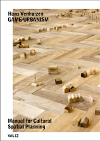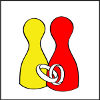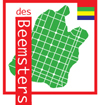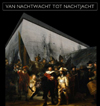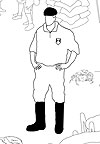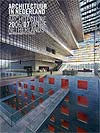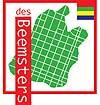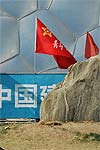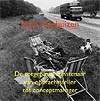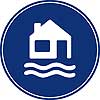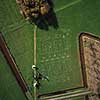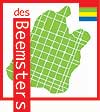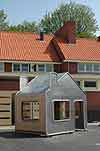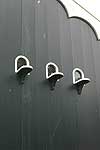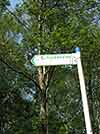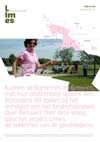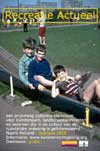 |
lecture
Seminar: The next 100 years. Future of housing.
Budapest (Hungary)
April 4, 2005 – The occasion for this seminar on architecture, housing
construction and planning in Budapest was the photographic exhibition about
a century of Dutch housing legislation. This exhibition was created in 2001
and since then has toured various countries in former Eastern Europe, on
each occasion accompanied by a symposium about residential construction
in the country concerned. The Roeleveld-Sikkens architecture bureau, which
also has an office in Budapest, organized the seminar for the Netherlands
Ministry of Housing, Spatial Planning and the Environment (VROM). Hans Venhuizen
was invited as a speaker. On the basis of a number of historical and modern-day
examples, Hans Venhuizen discussed cultural continuity in the built environment.
He argued that culture is a factor that can manifest itself during all phases
of the planning process and is therefore not something that you append or
invent later on. |
| |
|
 |
project
BULB
An education project on culture-based planning
March 2005 – For an assignment from the Erfgoedhuis Zuid-Holland (Heritage
Centre for South Holland), Bureau Venhuizen developed a website for young
people about culture-based planning in the Dune and Flowerbulb Region, in
association with designers and education experts. The aim of BULB is to
raise the awareness of students at secondary schools about the role that
cultural history and contemporary culture can play in the planning of the
built environment and the cultural landscape. The website has a layered
structure of ‘Looking – Learning – Doing’, which
coincides with the way in which culture-based planning is embedded in the
project Soul
and Soil. |
| |
|
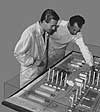 |
foundations
L,v and L,b Foundations Disbanded
March 2005 – Founded in 1992 by Hans Venhuizen, Marcel Smink and Frank
Hemeltjen, the Locus, velocitas (L,v) foundation was disbanded in March
2005. The foundation was active between 1992 and 1999 in the development
of a range of activities, from exhibition projects to creating an alternative
for BK-Informatie, an information source for the visual arts, and from a
proposal for an event about death and life to a business centre, for which
the L,b (Locus, bouricius) foundation was specifically set up. (more) |
| |
|
 |
project
No WAPLA for Leidsche Rijn
January 2005 – Despite the enthusiasm for the designs for the carwash
facilities shown by the client and representatives of carwash businesses,
the Leidsche Rijn project bureau has not succeeded in finding businesses
that can realize and operate the carwashes on the desired scale at the prospective
locations. The Wapla designs were warmly welcomed by a number of potential
licensees, but the business risk was still considered too great in the chosen
set-up. (more) |
| |
|
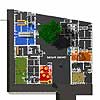 |
design commission
De Speelhoff: Dudok for Beginners
Proposal for a children’s playground at the Van ’t Hoffplein
in Hilversum
January 2005 – A large-scale urban renewal plan will be realized in
Hilversum Oost, the eastern section of Hilversum, over the coming years.
The objective is to preserve the typical style and character of the district,
designed by the former municipal architect Dudok. Besides housing, the public
space will undergo a thorough revamp. As part of the renovation of the Van
’t Hoffplein, the Municipality of Hilversum invited the artist Hans
Venhuizen to share his thoughts and ideas about plans for the layout of
the public garden and the relocation of the playground that currently stands
there. Venhuizen has a developed a concept for a collective children’s
playground based on the floor plans of the original Dudok dwellings. This
preserves an essential aspect of the original quality of the neighbourhood
at an unexpected spot. (more) |
| |
|
 |
publication
Geest en Grond (Soul and Soil): the book
December 2004 - The book ‘Geest en Grond, culturele planologie in
de Duin- en Bollenstreek’ presents the results of two years of discussion
and thought, observation, learning and designing for the Dune and Flowerbulb
Region with the deployment of cultural history in spatial developments as
the guiding principle. This handsome Dutch-language publication produced
by Bureau Venhuizen in association with the Erfgoedhuis Zuid-Holland (Heritage
Centre for South Holland). It can be ordered for € 29.50 via desk@bureauvenhuizen.com
and is available at better regional and national bookstores. ISBN 90-808898-1-4
|
| |
|
 |
symposium
Final Symposium for Geest en Grond (Soul and
Soil)
December 9, 2004 – What are the chances for a Mecca for senior citizens
in Warmond, a design for a new ruin in Voorhout, new business complexes
that beautify the landscape in Noordwijkerhout, and Spartan lodgings in
an old flowerbulb shed in Lisse. These themes and others were on the agenda
at the final symposium of Geest en Grond (Soul
and Soil), which presented the results of two years of research into
the integration of cultural history for spatial development in the Dune
and Flowerbulb Region. Design proposals were presented along with a commentary
from ‘project watchers’. The presentation was followed by a
round-table discussion chaired by Bert van Meggelen with Dirk Sijmons, Jan
van Grunsven, Marcel Vissers, Marc Witteman and other experts from the region.
(www.geest-en-grond.nl
> implementation) |
| |
|
 |
presentation
Conference on Space 2004 in Cruise Terminal Rotterdam
October 26, 2004 – The goals of the Ruimtelijk Planbureau (the Netherlands
Institute for Spatial Research), organizer of the Ruimteconferentie (‘Conference
on Space’), include exploring and highlighting spatially relevant
social trends. The Conference on Space tackles a whole range of space-related
themes which are presented in workshops and discussed. Hans Venhuizen gave
a talk on the basis of Geest en Grond (Soul
and Soil) about the role that cultural-historical qualities could play
in counteracting undesirable spatial developments in the Dune and Flowerbulb
Region. He presented The
Making of of methodology. Devised by Bureau Venhuizen, this methodology
is a game that functions as a generator of ideas, inspiring participants
to come up with innovative plans for spatial planning issues. Using ‘The
making of’ involves all concerned parties, local residents, administrators
and designers in the planning process from the very start and on an equal
footing. |
| |
|
 |
research project
Heemskerk: Wo ist der Bahnhof?
Apparent coincidences around Heemskerk station
November 2004 – Finding Heemskerk railway station still seems to present
a problem for people from outside the area. The station stands at the end
of a broad local access road that leads to a dead-end, far from the village
core and the last bus stop, hidden behind a supermarket. Though this station
enjoys excellent and direct connections to and from Haarlem and Amsterdam,
it does not exude this status and the opportunities it presents remain unexploited.
For example, the possibility of linking up the station with the new residential
development of Broekpolder, which is being constructed right next to the
railway line and where 8,000 potential train passengers will live. For a
commission from the Broekpolder Advisory Committee for the Visual Arts,
Bureau Venhuizen investigated the reasons for Heemskerk station’s
current status and encountered a series of apparent coincidences. (more) |
| |
|
 |
project
The Limes
The future of history
October 2004 – How might the Romans and Batavians be of help with
today’s spatial planning issues? This question was central to the
project ‘The Limes: the future of history’, for which Bureau
Venhuizen devised an action plan for the Netherlands Architecture Fund and
the Belvedere Project Bureau. The aim of this project is the translation
of cultural-historical qualities in general and those of The Limes in particular
into present-day spatial planning tasks, such as a design for the Over-Betuwe
Landscape Park. The possibilities presented by this translation are being
researched at various levels by artists, researchers, experts and designers
through to October 2005. (more) |
| |
|
 |
project
Cancellation of ‘Squaresaver’
September 2004 - For the ambitious ‘Squaresaver’ design, which
required a screensaver for the new marketplace in the city borough of Amsterdam
Zuidoost, the technology proved to be insufficiently reliable to install
it on such a large scale. Because construction of the square was accelerated
in 2004, the Squaresaver project had to be abandoned. |
| |
|
 |
presentation
Presentation of Implementation Projects
September 2004 – The results of the implementation projects for Geest
en Grond (Soul and Soil) were presented by the designers at a public event
for administrators, experts, the parties involved, residents and other interested
parties. Following the presentations there was a discussion about the plans
between the design team and the attendees. |
| |
|
 |
The Desired Landscape: beautifying the
landscape with new flowerbulb sheds
September 21, 2004 - Three design teams came up with solutions to promote
economic growth in the Dune and Flowerbulb Region, while retaining the diminutive
scale and an open landscape. Artgineering proposed the vital combination
of flowerbulb cultivation and tourism should in future be complemented by
the creation of land using excess silt from waterways. Twan Jütte’s
design for a half-submerged flowerbulb shed creates a realistic alternative
in an open landscape. The Copy_Paste design team developed a ‘nodes
strategy’ for the expansion of the industrial terrain on the Delfweg
in order to preserve the cultural-historical qualities of the flowerbulb
landscape. (www.geest-en-grond.nl
> implemantation) |
| |
|
 |
New Heritage: cultural history in a newly
built neighbourhood?
September 2, 2004 - In association with the Municipality of Voorhout, the
design team carried a study into the perception and potential application
of cultural-historical qualities in the design of a future residential area.
Using the discovered cultural-historical qualities such as the ribbon of
farmhouses, the polder landscape, flowerbulb cultivation and the millrace,
a number of proposals were elaborated further. (www.geest-en-grond.nl
> implementation) |
| |
|
 |
New Heritage: can cultural history create
space for Warmond?
September 2, 2004 - The Municipality of Warmond cannot expand: the red-line
zoning and the ‘kerosene contour’ around Amsterdam Airport Schiphol
set out in the new Nota Ruimte (‘National Spatial Strategy’)
allow no space at all for new construction. What might cultural-historical
qualities mean for breaking through this impasse? Can threats such as an
aging population and sprawl be marshalled as opportunities for a new spatial
strategy? And what are the possibilities for the old village heart? The
design team translated various cultural-historical and contemporary qualities
into a quartet of possible strategies to ensure a ‘vital’ Warmond
in the future. (www.geest-en-grond.nl
> implementation) |
| |
|
 |
Bulb & Breakfast: Old flowerbulb
sheds, new tourism
August 31, 2004 – How can Bulb & Breakfast best make its mark
on the tourist map of the region? Are lodging facilities themselves sufficient
or should they be marketed as a ‘cultural event’ combined with
music, art or recreation in the region? In the proposals, attention was
given to ideas that included a link with long-distance paths, a design for
a flexible and multifunctional space, and a marketing strategy with a logo
and merchandising, for example picnic rugs with the map of the flowerbulb
region in order to raise the project’s profile and make it commercially
interesting for the owners of flowerbulb sheds. (www.geest-en-grond.nl
> implementation) |
| |
|
 |
workshop
Norwegian University of Science and Technology, Trondheim (Norway)
September 2004 – On the invitation of the Norwegian University of
Science and Technology in Trondheim, Hans Venhuizen led a workshop on concept
development with fourth-year students of Urban Design and Planning. The
starting point was filling in a matrix of tasks and phenomena during an
expedition along the Norwegian coast near Trondheim. The students were studying
the area and collecting as much information as possible about social, economic,
spatial and political developments in the area. Key data were then transformed
into tasks (what to do) and phenomena (what plays a role). The matrix provides
the basis for the concept phase: specific combinations can lead to novel
insights and surprising finds from which (spatial) concepts can arise. |
| |
|
 |
lecture
Het Groene Woud (The Green Woods), Boxtel (the
Netherlands)
September 8, 2004 - In spring 2004, ‘Het Groene Woud’ (‘The
Green Woods’), a collection of nature areas and unique cultural landscapes
within the triangle formed by the cities of Den Bosch, Tilburg and Eindhoven
was designated as a ‘National Landscape’ by Dutch central government.
During the symposium, which ‘celebrated’ the granting of this
status, Hans Venhuizen talked about the cultural dimension of spatial planning.
Venhuizen emphasized the enormity of the cultural act that is represented
by the desire and the actual act, over the centuries, of structurally allowing
land to ‘revert to nature’ – land that was brought under
cultivation thanks to considerable effort, even if it is known as ‘nature’.
(more) |
| |
|
 |
article
Tracking context and phenomena
The cultural dimension as the driver of spatial planning
April 2004 - Article in S&RO (4/2004): Anne Luijten and Denise Vrolijk
in conversation with Hans Venhuizen about authenticity, the eye of the artist,
imagination, and the process by which content is created. (more) |
| |
|

 |
workshop
Geest en Grond (Soul and Soil): Winners at Work
in the Dune and Flowerbulb Region
June/July 2004 - Does cultural history provide impulses for future developments
in the Dune and Flowerbulb Region? Will old flowerbulb sheds become new
cabins for hikers in a Europe-wide network of accommodations for long-distance
walkers? Can the use of excess silt help preserve the open landscape and
stimulate new tourism-related opportunities? What does cultural history
actually mean to the local residents and how can the region’s contemporary
culture be involved in future developments? During the workshops, designers
and architects worked on the winning plans from the competitions together
with various experts, elaborating them for a number of actual locations
in the Dune and Flowerbulb Region. (www.geest-en-grond.nl
> implementation) |
| |
|

 |
festivities
New Office Opens
June 11, 2004 - Since June 2004, Bureau Venhuizen has been based in the
Van Nelle Factory, in the section where the engineering workshop used to
be. The Van Nelle Factory was built between 1925 and 1931 to a design by
the architects J.A. Brinkman and L.C. van der Vlugt. With regard to the
history of architecture, the factory complex is unique. The client and the
architects wanted the building to give the phenomenon of factories an ‘attractive’
and undiluted character. The organization and layout of the buildings was
intended to contribute to a new work ethic. The building is also considered
a textbook example of architecture in the Nieuwe Zakelijkheid (‘New
Objectivity’) style, the Dutch take on functionalism. (contact) |
| |
|
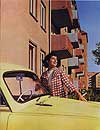 |
study trip
Alles wird gut
Study Trip to Central and Eastern Europe 200
May 2004 - In April and May 2004, artists, writers, journalists and architects,
including Hans Venhuizen, took part in a study trip through Central and
Eastern Europe. For the essay bundle inspired by the trip, Ideals in Concrete,
Hans Venhuizen wrote the article ‘Alles wird gut’, in which
he outlines the attitude adopted by many city governments in former East
Germany with regard to the exodus from their cities. Instead of beginning
from the situation as it stands and seeking out realistic possibilities
for development within this, the cities attempt to turn the tide with ‘Alles
wird gut’ – future predictions that are based on speculative
assumptions.
(more) |
| |
|

 |
festivities
Prize Presentation for Geest en Grond (Soul and
Soil)
April 2004 – On Friday, April 2, the chairman of the jury, Bert van
Meggelen, announced the prize-winners from the final round of the three
competitions: Bulb & Breakfast, The Desired Landscape and New Heritage.
The prizes were presented by Mr. M. Houtman, chairman of the Erfgoedhuis
Zuid-Holland (Heritage Centre for South Holland) and Mr. M. Witteman, chairman
of the Pact of Teylingen Steering Committee. The international ideas competition
for Geest en Grond (Soul and Soil) resulted in 123 innovative proposals,
of which 27 were submitted from abroad. Plans from the Randstad to the region
itself and from Milan to Buenos Aires were honoured with prizes. (www.geest-en-grond.nl
> competition) |
| |
|
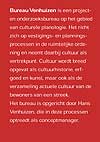 |
publication
Bureau Venhuizen
December 2003 – The Bureau Venhuizen brochure presents the bureau’s
methodology on the basis of three projects: Amphibious Living, The making
of Mheenpark and Geest en Grond (Soul and Soil). The English-language brochure
can be downloaded here (Bureau
Venhuizen, pdf file 450 KB) or ordered via desk@bureauvenhuizen.com. |
| |
|
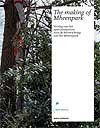 |
publicatie
The making of Mheenpark
November 2003 – In the publication The making of Mheenpark there is
a report on the open planning process that Bureau Venhuizen devised and
facilitated for the transformation of Mheenpark. The game ‘The making
of’, which involves local residents in the spatial planning process,
was applied to decide the preconditions for the transformation. The results
of the comprehensive invent, the various rounds of the game and the provisional
design are summarized in the brochure. The brochure can be downloaded (The
making of Mheenpark, pdf 1,7 MB) or ordered via
desk@bureauvenhuizen.com. |
| |
|
 |
project
Geest en Grond (Soul and Soil)
Culture-based planning in the Dune and Flowerbulb Region
January 2003 - December 2004 - In Geest en Grond (Soul
and Soil), Bureau Venhuizen investigated the role that cultural history
can play in the future spatial layout of the Dune and Flowerbulb Region
from 2002 through to 2004. In answer to a commission from the Erfgoedhuis
Zuid-Holland (Heritage Centre for South Holland), Bureau Venhuizen developed
a process for Geest en Grond (Soul and Soil) that consisted of three phases:
inventory, competition and implementation. An inventory was drawn up of
the themes that are relevant in the Dune and Flowerbulb Region, and especially
the spatial impact these have, or might have. The competition briefs were
distilled from this material, and architects, designers, artists and local,
hands-on experts were welcome to participate. During the implementation
phase, and in collaboration with three local municipalities, the best proposals
were elaborated by designers for specific locations in the region. You can
read more about the Geest en Grond (Soul and Soil) project at www.geest-en-grond.nl
and in the Dutch-language publication Geest
en Grond, culturele planologie in de Duin- en Bollenstreek. |
| |
|
 |
project
WAPLA The art of car washing
Artists design car-wash facilities for Leidsche Rijn
September 2003 – On the initiative of BEYOND (the multi-year art project
in Leidsche Rijn), eight artists, architects and designers worked on the
design of car-wash facilities for Leidsche Rijn. Residents are not allowed
to wash their cars on the street, because of the environmentally friendly
water system, and must use special car-wash facilities instead. The designs
were bundled in a catalogue. Candidate franchisers could submit a bid to
manage a Wapla facility by public tender, and had to choose a design from
the catalogue. At the end of April it will be decided which design will
be used. Bureau Venhuizen is responsible for the concept management in this
process. (more) |
| |
|
 |
project
The making of ©Bureau Venhuizen 2001
April 2003 - The game methodology ‘The making of’ was used in
2003 for the transformation of the Mheenpark in Apeldoorn. The game, which
is played by 50 local residents of all ages, was an important step in establishing
the criteria for the park’s redesign. The results of a comprehensive
inventory and the various rounds of the game served as input for the design
brief for the municipal designers. Starting in 2005, the design will be
realized in phases. (more) |
| |
|
 |
project
Squaresaver
An ambitious square in Amsterdam Zuidoost
November 2002 - The Squaresaver project by Bureau Venhuizen for the future
Anton de Komplein in the Borough of Bijlmermeer, Amsterdam, is currently
under development. In March 2002, there was a follow-up to the proposal
in the form of a commission for a draft design. A project team is currently
working on the realization of the design, a process that depends on existing
and innovative technological possibilities. An interesting development in
this regard is the possibility of using a computer to remotely control the
blocks with LEDs. This could mean massive cost reductions, as it would leave
existing underground infrastructure undisturbed and maintenance could be
carried out at ground level. (more) |
